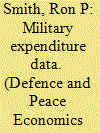|
|
|
Sort Order |
|
|
|
Items / Page
|
|
|
|
|
|
|
| Srl | Item |
| 1 |
ID:
153086


|
|
|
|
|
| Summary/Abstract |
The effects of military spending has on the economy continues to be a subject of considerable debate, with a lack of consensus in the literature. This paper takes advantage of the Stockholm International Peace Research Institute extended data-set to contribute to the debate using empirical methods made available, or more applicable, by the extra observations. It constructs a large panel of countries for the period 1970–2014 to explore the long-run equilibrium relationship between military spending and economic growth, applies the more flexible pooled mean group estimator, and compares the results with the more restrictive dynamic fixed effect method used in earlier influential studies. It also compares results from different time and country samples. Across the specifications it finds a significant and persistent negative effect of military burden on economic growth that is robust across different country groups, with the largest impact being for OECD countries.
|
|
|
|
|
|
|
|
|
|
|
|
|
|
|
|
| 2 |
ID:
153089


|
|
|
|
|
| Summary/Abstract |
In this paper, we use new data on military expenditure (milex) compiled by the Stockholm International Peace Research Institute (SIPRI) to investigate the relationship between military spending and economic growth. We focus on selected countries in Indo-Pacific Asia – an economically diverse but increasingly prosperous region with pockets of strategic competition and growing milex. We confirm the robustness of SIPRI’s milex data by corroborating it with defence budget data published by Australia’s Defence Intelligence Organisation (ADIO). We find no conclusive evidence of an arms race in the region. It is the growing economic prosperity that accounts for most of the growth in Indo-Pacific Asia’s milex. But we also find wide variations in the economic burden imposed by milex at the national level and that milex’ high level of aggregation masks important changes in national military capabilities.
|
|
|
|
|
|
|
|
|
|
|
|
|
|
|
|
| 3 |
ID:
153087


|
|
|
|
|
| Summary/Abstract |
Strategic interactions between countries, such as arms races, alliances and wider economic and political shocks, can induce strong cross-sectional dependence in panel data models of military expenditure. If the assumption of cross-sectional independence fails, standard panel estimators such as fixed or random effects can lead to misleading inference. This paper shows how to improve estimation of dynamic, heterogenous, panel models of the demand for military expenditure allowing for cross-sectional dependence in errors using two approaches: Principal Components and Common Correlated Effect estimators. Our results show that it is crucial to allow for cross-sectional dependence, that the bulk of the effect is regional and there are large gains in fit by allowing for both dynamics and between country heterogeneity in models of the demand for military expenditures.
|
|
|
|
|
|
|
|
|
|
|
|
|
|
|
|
| 4 |
ID:
153085


|
|
|
|
|
| Summary/Abstract |
This paper discusses some of the methodological issues involved in analysing military expenditure data, with particular reference to the extended SIPRI data-set. The discussion is organised under the headings of validity, what is the appropriate concept to measure? reliability, how well is it being measured? and comparability, is the same thing being measured over time and space? The paper then considers some of the econometric issues involved in the use of such data.
|
|
|
|
|
|
|
|
|
|
|
|
|
|
|
|
| 5 |
ID:
153084


|
|
|
|
|
| Summary/Abstract |
SIPRI has collected data on military expenditure almost since its foundation in the 1960s, but various historical difficulties led to breaks in the consistency of the data series, so that until recently SIPRI’s consistent military expenditure database has only provided data from 1988 onwards. This paper describes recent efforts at SIPRI that have succeeded in extending these consistent series for most countries back to at least the 1960s, and in some cases to 1949. It describes the underlying difficulties involved in collecting military expenditure data and ensuring consistent series, the sources used in the reconstruction of the long data-set, the methodological choices made, and the results of the exercise. Overall, consistent constant price data series have been extended back as far as 1957 for half of the countries covered by the SIPRI database that existed at the time. Europe and the Americas generally have the best data coverage. One of the biggest problems with the extended data-set is the extensive use of estimates to splice together overlapping, but disagreeing series for the same country, adjusting the older series upwards or downwards by an appropriate ratio to give greater consistency with the later series. A number of case studies are investigated where parallel series exist for countries, suggesting that this approach may in some cases involve significant margins for error.
|
|
|
|
|
|
|
|
|
|
|
|
|
|
|
|
| 6 |
ID:
153088


|
|
|
|
|
| Summary/Abstract |
This paper analyzes the impact of arms imports and exports on national military expenditures. The recent literature on the determinants of military expenditures has mainly focused on countries’ external security environments and their regime type. Based on existing theoretical work, we argue that, in addition to these factors, arms trade flows may have an important role to play. First, we show that rising imports of major conventional weapons do not necessarily translate into higher defense spending. Rather, this relationship depends on political, economic, and contract conditions that influence different choices of financing imports. Therefore, the effect should be very heterogenous. Second, exports may have both a negative or a positive impact depending on regime type and the perceived impact of exports on national security. We empirically test these expectations for 156 countries from 1949 to 2013 using arms trade and new military expenditure data provided by SIPRI. Employing static and dynamic panel data models, we find that the effect of arms imports on defense budgets does indeed differ between regions and time periods. With respect to exports, there is evidence of a strategic substitution effect between military expenditures and arms exports in democratic countries: increases in arms exports are followed by a reduction in military expenditures. For non-democratic societies on the other hand, arms exports do not tend to be associated with lower military spending.
|
|
|
|
|
|
|
|
|
|
|
|
|
|
|
|
|
|
|
|
|